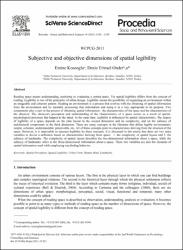Subjective and Objective Dimensions of Spatial Legibility
Citation
KÖSEOĞLU, Emine & Deniz ERİNSEL ÖNDER. "Subjective and Objective Dimensions of Spatial Legibility." Procedia - Social and Behavioral Sciences, 30 (2011): 1191-1195.Abstract
Reading space means understanding, analyzing or evaluating a certain space. Yet spatial legibility differs from the concept of
reading. Legibility is one of the principles of urban design. Legibility means the possibility of organizing an environment within
an imageable and coherent pattern. Reading an environment is a process that evolves with the obtaining of spatial information
from the environment and by mentally processing that information and using it in a way appropriate to its purpose. Two
components play a part in the process of obtaining spatial information: the characteristics of the space and the characteristics of
the observer. The observer's perception and understanding of the characteristics of a space occurs as a result of spatialpsychological
processes that happen in the mind. At the same time, legibility is influenced by spatial characteristics. The degree
of legibility of a space depends on the plan layout in the second dimension and its complexity, and on the saliency of
architectural components in the third dimension. There are many concepts in the literature that define legible environments:
simple, coherent, understandable, perceivable, etc. All of these concepts point to characteristics deriving from the structure of the
space. However, it is impossible to measure legibility by these concepts. It is discussed in this article that there are two main
variables to devise a definition based on characteristics deriving from space: 1. the complexity of spatial layout and 2. the
saliency of landmarks. The complexity of spatial layout describes the two-dimensional information about a space, while the
saliency of landmarks refers to the three-dimensional information about a space. These two variables are also the elements of
spatial information used while employing wayfinding behavior
URI
http://www.sciencedirect.com/science/article/pii/S1877042811020568https://hdl.handle.net/11352/1863
Collections
- Mimarlık Bölümü [152]



















